From Loughborough to Lambeth
By J D Bennett for the Leicestershire Historian
If you look at a railway map of South London, you will see a station called Loughborough Junction, on
the line going south from Blackfriars.
Loughborough Junction was originally called Loughborough Road, and between there and Brixton was another station called Loughborough Park (later renamed East Brixton and now closed).
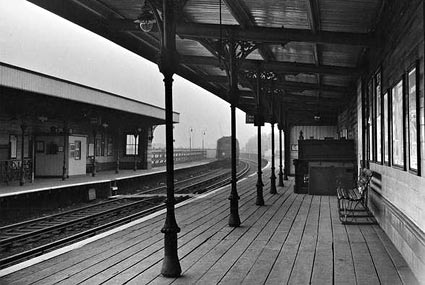
East Brixton railway station, 1964. See feature.
As well as those stations, and the thoroughfares of Loughborough Road and Loughborough Park, a row of early nineteenth century houses in Brixton Road called Loughborough Place, a block of flats called Loughborough Mansions, a row of shops called Loughborough Parade, Loughborough Park Congregational Church and the Loughborough Park Tavern, in Coldharbour Lane, all provide evidence of a link between seventeenth-century Leicestershire and an area that was once part of Surrey but is now in the London Borough of Lambeth.
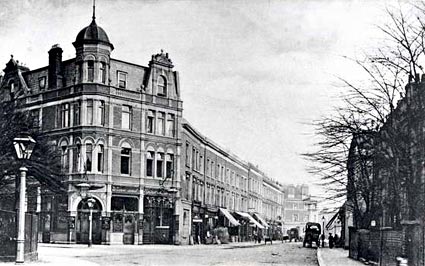
Loughborough Hotel
That link was provided by  Henry Hastings, first Baron Loughborough (c.1609-1667), to whom the manor of
Lambeth Wick, of which this land once formed part, was leased. Henry Hastings, first Baron Loughborough (c.1609-1667), to whom the manor of
Lambeth Wick, of which this land once formed part, was leased.

The younger son of the fifth Earl of Huntingdon, he was born at the Manor House on Sparrow Hill, Loughborough.
During the Civil War, as Colonel Hastings, he was an important Royalist commander and led troops at Edgehill in 1642, was involved in the relief of Newark in 1644, became governor of Leicester in 1645 and held Ashby Castle till 1646.
In 1649 he escaped to Holland, but returned to England in 1660 and was appointed Lord Lieutenant of Leicestershire the following year.
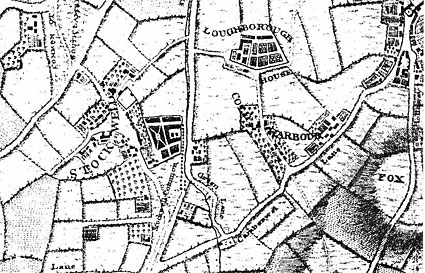
Loughborough House. John Rocque's map of 1745.
In 1664 he was living at the manor house of Lambeth Wick, which became known as Loughborough House,
and in that year obtained an Act of Parliament to make the river Effra navigable from Brixton Causeway to the Thames, but died before his project could be implemented.

By the beginning of the 18th century, the Hastings family were no longer lessees of the manor of Lambeth
Wick. Loughborough House became 'a superior academy for young gentlemen'; a collection of elocution
lessons published in 1787 was dedicated 'To the Young Noblemen and Gentlemen receiving their education at
Loughborough House School'.
A drawing in Lambeth Archives of c.1825 shows it as a three-storey house of ten bays, which had clearly been rebuilt, or at least refronted, since Henry Hastings' time. It still had 30 resident pupils at the time of the 1841 census.
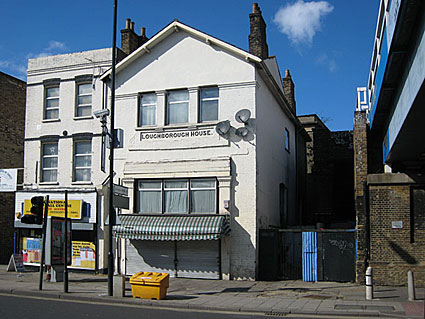
Loughborough House, Coldharbour Lane, Brixton, Nov 2007. This has no relation to the old house in this article.
Piecemeal development of Lambeth Wick had started in 1820, and the laying out of roads like Loughborough
Park from 1844 onwards, the demolition of Loughborough House in 1854, and the opening of the lines to Central London in the 1860s and early 1870s, coupled with the availability of cheap, early morning workmen's fares, accelerated the transformation of the area into a railway suburb.
The manor of Loughborough remained in the possession of the Hastings family until 1810, though the building on Sparrow Hill which is still known as the Manor House was sold by them in 1654. After many owners and changes of use, it has been restored and is now a hotel and restaurant.
(This article reproduced with the kind permission of Leicestershire Archaeological and Historical Society. The Society was founded in 1855 'to promote the study of history, archaeology, antiquities and architecture of the county'.)

FURTHER RESEARCH: LOUGHBOROUGH HOUSE
"The original house stood on the triangular-shaped piece of ground now covered by Evandale, Claribel, parts of Loughborough, Lilford and Akerman Roads, stood Loughborough House and grounds.
The house itself, shown on a plan of 1825 (ref. 33) as an oblong range of buildings facing west with its south side abutting on Loughborough Lane, stood on the site of the south-east corner of Evandale Road and part of the roadway.
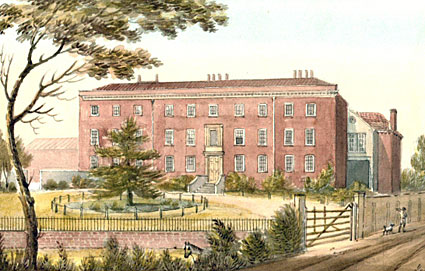
Loughborough House, 1825.
A drawing in Lambeth Archives of c.1825 shows it as a three-storey house of ten bays, which had clearly been rebuilt, or at least refronted, since Henry Hastings� time. It still had 30 resident pupils at the time of the 1841 census.
The house was pulled down about 1854."
 British History Online British History Online
 Map location Map location
Note: A 'bay' originally meant a section of a building between a column or buttress. However, if a larger building has a regular pattern of windows one above the other, it is often used to mean to refer to each section of the building regardless of whether there are pillars between - so Loughbrough House gets described as a ten bay building as it was a building with ten sets of windows across the width of the front.
(With thanks to Crispy, lang rabbie and urban75 bulletin board contributors)
« Brixton features home
|
|

